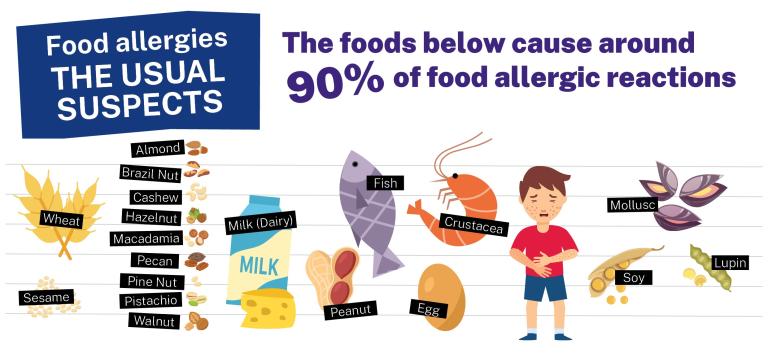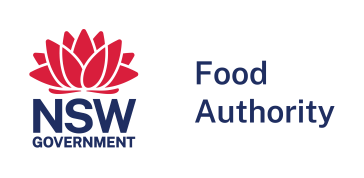
- Print this page
- Download as PDF
- Share this page
Food allergy is an invisible condition that is common in Australia. In fact, around 1 in every 10 babies and children has a food allergy.
Food allergies can be really scary for some people and can even be life threatening, so it is important you always take them seriously.
There are a few simple things you can do every day to help keep people with food allergies safe.
What is a food allergy?
A food allergy is when someone has an allergic reaction when they eat or drink a food they are allergic to.
Their body’s immune system, which is the part that fights off germs that make us sick, thinks the food is harmful, even though it’s not.
The immune system tries to attack and destroy the food. It tells the body to make changes to help “fight” the food, called symptoms.
Symptoms vary for different people, and for some, can be fatal.
Food allergy symptoms
You can’t tell someone has a food allergy just by looking at them. It is only when they eat a food they are allergic to that they can become sick. Some people can become very sick, very quickly.
Even tiny amounts (traces) of the food they are allergic to – less than a crumb or a drop - can cause an allergic reaction.
Symptoms are the signs you might see when someone is having an allergic reaction. Signs of an allergic reaction can be different for different people, and can make some people really, really sick.
Most allergic reactions are what we call mild to moderate and do not make people very sick. They can be uncomfortable and may change how a person looks or feels for a little while.
For some people their food allergy can cause a severe allergic reaction called anaphylaxis. Anaphylaxis means the body has made changes in the way a person breathes or how blood is pumped around the body by the heart.
Some of the symptoms are:
- swelling of the lips, tongue, face and eyes (a swollen tongue can make it hard to breathe)
- swelling or tightness in the throat
- hives, itchiness or rash
- tingling mouth
- noisy or difficulty breathing
- wheeze or cough
- difficulty talking or hoarse voice
- dizziness or collapse
- going pale and floppy.
Sometimes anaphylaxis can happen very quickly, and sometimes a mild to moderate allergic reaction gets worse and becomes anaphylaxis.
Foods that cause allergic reactions
Anything that causes an allergic reaction is called an allergen. Many different food products contain allergens and it can be surprising what they are in. In fact, there are more than 170 foods known to have caused allergic reactions! There are some foods which cause allergic reactions in lots of people - these are called common food allergens.
When people have food allergy, they are told by their doctor not to eat the food they are allergic to. Food that someone is allergic to can be hidden in another type of food. For example, milk, egg or walnuts in a muffin. That’s why people with a food allergy always need to know what is in food or drink before they eat it.
Rules for the most common allergens
There are rules to help people find common food allergen information quickly and easily on food labels. If any of the most common allergens are in a food, a food label needs to clearly name them in a certain way.
The most common allergens are:
- wheat
- egg
- milk
- peanut
- lupin
- soy
- sesame
- almond, Brazil nut, cashew, hazelnut, macadamia, pecan, pine nut, pistachio, walnut
- fish
- crustacean (such as prawn or crab)
- mollusc (for example, oysters and mussels).
Other foods which also HAVE to be written on food labels in a certain way:
- sulphites
- gluten
- barley
- oats
- rye.
Gluten - a group of proteins found in some grains - can also make some people very sick and is in included in the food label rules for allergens. This means foods containing gluten, such as barley, oats, rye and wheat must also be named in a certain way.
If a person has a food allergy to a food that it is not a common allergen, it must still be written in the ingredients list, but they may have to look harder to find it.
Food businesses must:
- declare allergens on the label, or
- display allergen information next to food that does not require a label, or
- provide allergen information if requested by a customer
- provide their customers with the food they ask for.

How you can help
If someone tells you they have an allergy, you need to take it seriously. Ask them what they’re allergic to, help them avoid it, and know what to do if they have an allergic reaction.
You should:
- Never share food, drink bottles or knives, forks, spoons, or straws, even if you think the food is safe.
- Wash your hands after eating, especially if you eat something your friend is allergic to.
- Be mindful where you eat at school and avoid eating in the playground. If you eat a cheese or peanut butter sandwich in the playground and it gets on the equipment, it will make it less safe for children with dairy or peanut allergies. (Remember, even a tiny amount can cause a reaction.)
- Try not to make a mess when you are eating. If you do make a mess, make sure it’s cleaned up.
- Never tease, trick, bully or joke about someone’s allergy. This doesn’t just hurt their feelings, it can also be very harmful and even dangerous.
- Don’t leave someone out because of their food allergy.
What to do if someone is having an allergic reaction
If you think someone is having an allergic reaction, quickly get help from an adult - even if the person having the reaction does not want you to.
The person having the reaction should not stand or walk. They should lay down on the ground, or sit on ground if it’s hard to breathe, while an adult quickly brings emergency medicine to them.
If they are experiencing anaphylaxis, they will need immediate treatment with an adrenaline (epinephrine) device (such as EpiPen® or Anapen®).
Recap
- A food allergy is a medical condition where a person’s immune system reacts to a food because it thinks it’s a threat.
- Food allergies must be taken seriously. They are not about disliking a food.
- Reactions can range from mild to severe. A severe allergic reaction is known as anaphylaxis, which is life threatening.
- A food that causes an allergic reaction is called an allergen. Even a tiny amount can cause a reaction.
- You should never share food at school and always wash your hands after eating.
- Ask your friends what they are allergic to and help them avoid it.
- If you think your friend with food allergy looks sick, tell an adult straight away.
More information
Allergy & Anaphylaxis Australia is a registered charity dedicated to helping individuals and carers to manage allergies. Their website has a lot of useful information, for example:
